
Verena Scheffczyk
Wednesday 22 January 2025

App development costs in 2025: from $4,000 no-code builds to $300,000+ for complex solutions. Compare methods, unlock savings, and master the budgeting strategies every founder needs to know.
Posted in:
Startups
The cost of building an app in 2025 depends on numerous variables: app complexity, platform choice, design, maintenance, and development method. While a simple app can cost between $10,000–$50,000 for traditional coding, no-code platforms can bring these costs down significantly, starting at just $4,000. For complex apps, coded solutions can exceed $300,000, while no-code options still offer a more affordable path.
This guide dives deep into every aspect of app development costs, offering clarity on budgeting and maximizing value while avoiding pitfalls. Whether you're planning to create a minimal viable product (MVP) or a feature-rich, enterprise-level app, this breakdown will guide you every step of the way.
App Development Cost Overview by Complexity
Coded vs. No-Code Cost Comparison

Source: Business of Apps
Factors influencing these figures include functionality, platform choice, and team location. No-code platforms significantly reduce both cost and development time while simplifying iteration cycles.
Breaking Down the Costs: Development Stages
1. Discovery Phase (10-15% of Budget)
The discovery phase involves defining the app's core purpose, features, and user base. Tasks include market research, wireframing, and creating a project roadmap.
Estimated Cost: $5,000–$40,000
Timeframe: 1–4 weeks
Key Deliverables:
Competitor analysis
MVP definition
Feasibility assessment
2. Design Phase (20-25% of Budget)
The design process shapes your app's user experience (UX) and interface (UI). Custom elements, complex interactions, and branding will increase costs.
Estimated Cost: $10,000–$50,000+
Timeframe: 2–12 weeks
Key Deliverables:
Interactive prototypes
Wireframes and mockups
UI/UX optimization
3. Development Phase (40-55% of Budget)
The coding phase translates your design into a functioning app. Backend and frontend development, feature integrations, and data architecture are key components.
Estimated Cost: $30,000–$300,000+
Timeframe: 3–12+ months
Key Costs:
Backend: $20,000–$80,000
Frontend: $10,000–$50,000
Third-party API integrations: $5,000–$20,000
4. Testing and Deployment (15-20% of Budget)
Testing ensures your app functions flawlessly across devices. Post-testing, deployment involves publishing the app on platforms like the Apple App Store or Google Play Store.
Estimated Cost: $5,000–$50,000
Timeframe: 2–8 weeks
Testing Types:
Functional testing
Regression testing
Usability testing
Key Factors Influencing App Development Costs
1. Feature Complexity
More features = higher costs. Simple apps include login and notifications. Complex apps might integrate real-time data syncing, AI, or augmented reality.

Source: GoodFirms
2. Platform Choice
iOS vs. Android: Developing for a single platform is cheaper than both. Costs are roughly equal for iOS and Android.
Cross-Platform Development: Frameworks like Flutter reduce costs by allowing one codebase for both platforms.

Source: Clutch
3. Team Location and Rates
The cost of hiring developers varies globally.

Source: Good Firms
Hidden Costs of App Development
1. App Store Fees
Apple: $99/year
Google: $25 (one-time)
Both platforms take 15-30% of in-app purchases.
2. Infrastructure and Maintenance
Servers: $1,000–$20,000 annually
Updates: $10,000–$50,000 per year
Bug Fixes: $1,000–$10,000 annually
3. Marketing and User Acquisition
Ads, SEO, social media, and PR can consume 50-100% of your development budget.
Optimizing Your App Development Budget
Start with an MVP
Focus on core functionality. Test user response before scaling.
Leverage Cross-Platform Tools
Flutter or React Native can save time and costs for multi-platform apps.
Outsource Smartly
Eastern Europe and South Asia offer quality development at lower rates.
Use Scalable Infrastructure
Opt for cloud solutions like AWS or Google Cloud to reduce initial costs.
Real-World Estimates of Coded App Costs

Real-World Estimates of No-Code Apps Cost

In a Nutshell
No-code development can reduce costs by up to 5x and cut development time in half compared to traditional coding methods.
No-code platforms simplify processes like discovery, design, and deployment, reducing upfront design costs by as much as 80%.
Advanced features like AI chatbots or AR are 2x-5x cheaper to implement with no-code platforms compared to custom coding.
Examples like Meetaway and Qoins show how no-code apps can achieve significant functionality for under $50,000.
Key insights into optimizing app budgets, including leveraging no-code platforms for MVPs or startups while recognizing the limits for highly technical projects.
Ready to take the first step? Contact Million Labs today for a tailored app development solution that fits your goals and budget.
👉 Check more recommended resources to Start, Launch and Grow your SaaS:
Ready to launch your startup idea with an MVP?
Download our step by step guide for non-technical founders to create a startup Minimum Viable Product (MVP)
Get the eBook

